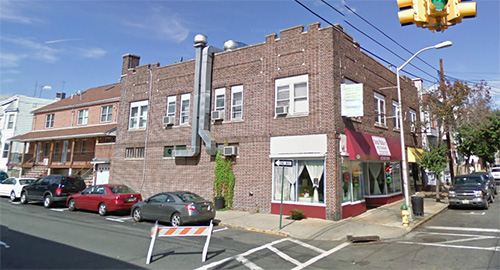Updated with Additional Video
On March 10, 2013 five Harrison, New Jersey firefighters were injured in an explosion while working at a commercial fire at 600-602 Frank E. Rodgers Boulevard. The fire originated in a two-story commercial building at the corner of Frank E. Rodgers Boulevard North and Davis Street and extended into Exposures Charlie and Delta, two-story residential buildings.
Figure 1. Alpha/Bravo Corner and Exposure Charlie

Image from Google Maps, click on the link to walk around using Street View.
Reading the Fire
Before watching the video (or watching it again if you have already seen it), download and print the B-SAHF Worksheet. Using the pre-fire photo (figure 1) and observations during the video, identify key B-SHAF indicators that may have pointed to potential for extreme fire behavior in this incident.
Important! Keep in mind that there is a significant difference between focusing on the B-SAHF indicators in this context and observing them on the fireground. Here you know that an explosion will occur, so we have primed the pump so you can focus (and are not distracted by other activity).
Backdraft or Smoke Explosion
While smoke explosion and backdraft are often confused, there are fairly straightforward differences between these two extreme fire behavior phenomena. A smoke explosion involves ignition of pre-mixed fuel (smoke) and air that is within its flammable range and does not require mixing with air (increased ventilation) for ignition and deflagration. A backdraft on the other hand, requires a higher concentration of fuel that requires mixing with air (increased ventilation) in order for it to ignite and deflagration to occur. While the explanation is simple, it may be considerably more difficult to differentiate these two phenomena on the fireground as both involve explosive combustion.
- Did you observe any indicators of potential backdraft prior to the explosion?
- Do you think that this was a backdraft?
- What leads you to the conclusion that this was or was not a backdraft?
- If you do not think this was a backdraft, what might have been the cause of the explosion?
For more information in Backdraft, Smoke Explosion, and other explosive phenomena on the fireground, see:
- Smoke Explosion and Backdraft
- Explosions During Structural Firefighting
- Lima, Peru: Backdraft
- Chicago Extreme Fire Behavior: Analysis of Fire Behavior Indicators
- Sudden Blast
- Gas Explosions
- Extreme Fire Behavior: An Organizing Scheme
- Backdraft at 62 Watts Street
- Fire Gas Ignitions
Back at it!
I would like to say thanks to all of you who have sent e-mail or contacted me on Facebook inquiring about the status of the CFBT-US blog. The last several years have been extremely busy at Central Whidbey Island Fire & Rescue and my focus has been almost exclusively on the fire district. However, I am renewing my commitment to developing knowledge of practical fire dynamics throughout the fire service and will endeavor to return to posting on a regular basis. In addition, I am working on a series of short (10-minute) drills on fire dynamics that will be cross posted on the CFBT Blog and the Fire Training Toolbox.
Ed Hartin, MS, EFO, MIFIreE, CFO